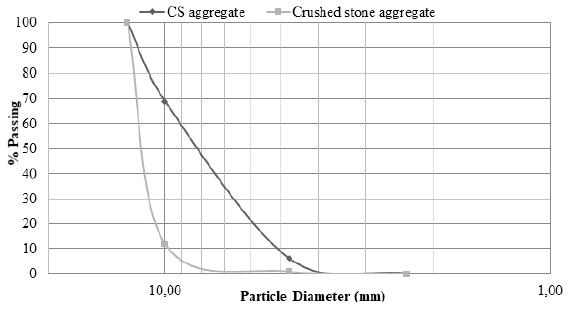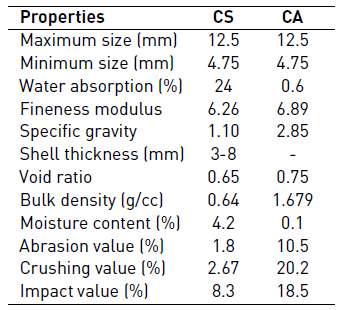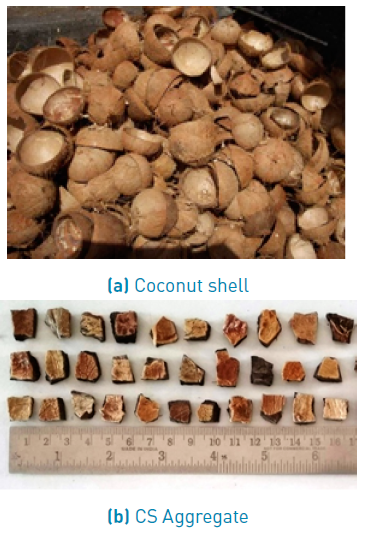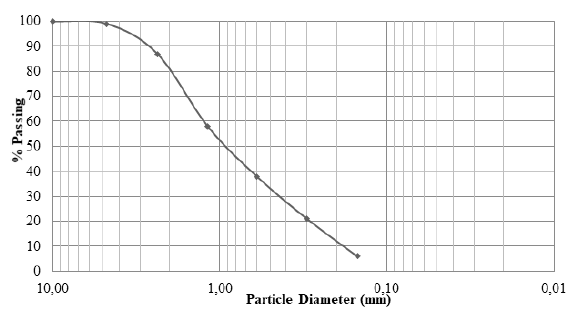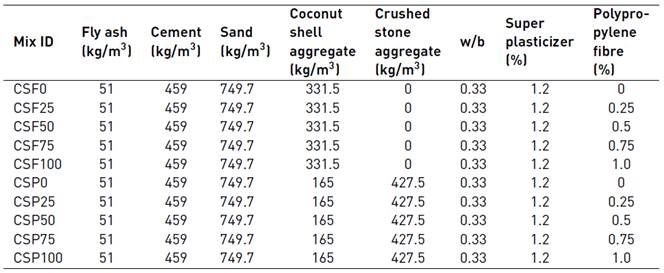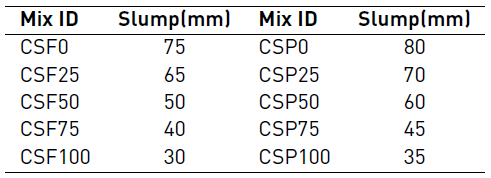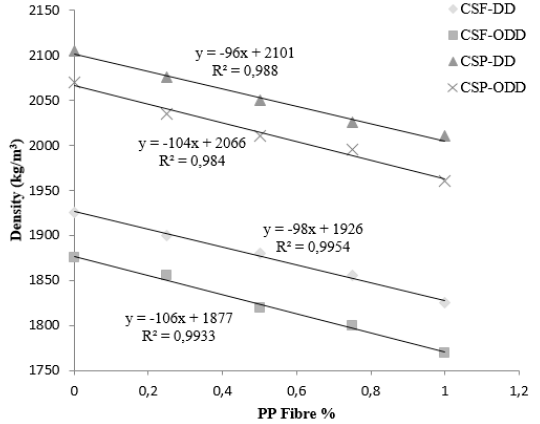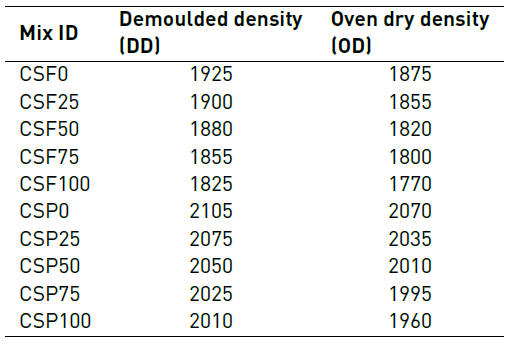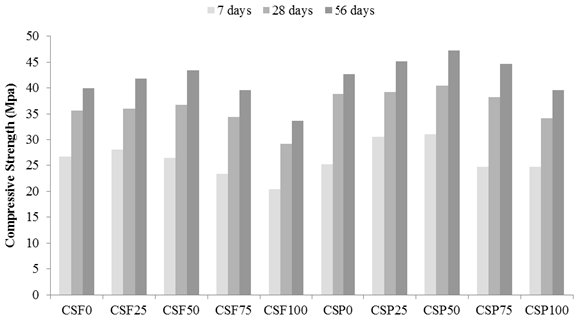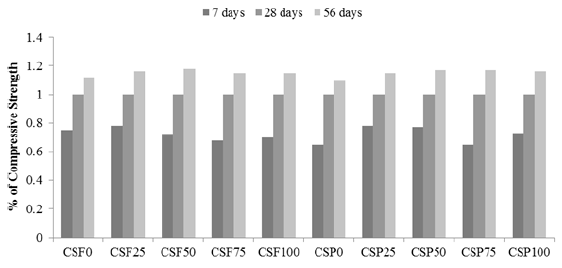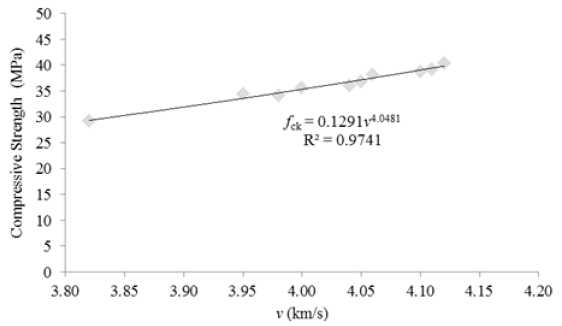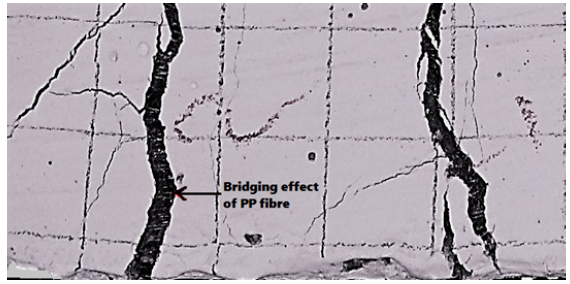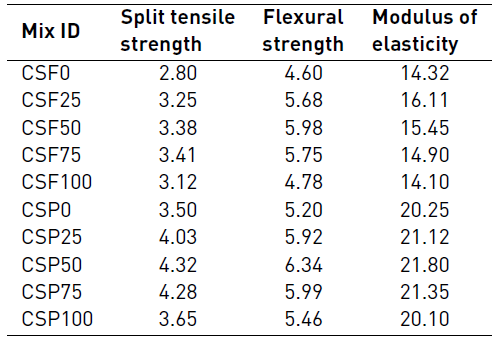1. Introduction
Environmental sustainability may be interpreted as the ability to indefinitely retain the rates of renewable resource use and non-renewable resource depletion. ‘Sustainability’ is one of the most discussed but least understood words in the world. For most nations, organisations and people who consider its importance, sustainability means the conservation of the Earth and basic issues related to improvement, such as the productive utilisation of resources, stable economic growth, consistent social advance and poverty elimination. Sustainable construction aims to meet current requirements for housing, working environment and infrastructure without compromising the capacity of future generations to meet their own needs. Authors in literature [1] reported that the current stage of the construction sector is unsustainable. Environmental sustainability can be achieved in this sector by replacing conventional aggregates in concrete with solid waste aggregates. Coarse and fine aggregates account approximately 60%-80% of concrete volume [2]. But, the main problem that undermines the use of natural coarse aggregates is sustainability, as it leads to other ecological problems [3]. According to the Ministry of Agriculture and Farmer’s Welfare of India, more than 23900 million coconut nuts have been produced in India in 2016-2017 [4] and this will simultaneously increase the agriculture solid waste accumulation.
Hence, the effective utilisation of agro-wastes, as replacement for traditional aggregates, contributes to the conservation of non-renewable resources, reduces energy consumption and lowers the costs of building materials. Researchers have already used several waste materials in concrete, including recycled concrete, silica fume, ground-granulated blast-furnace slag, fly ash, waste tyre rubber, post-consumer glass and waste plastics [5,6]. Similarly, coconut shell (CS), palm kernel shell, oil palm shell (OPS), rice husk, corn cob, pistachio shell, spent mushroom substrate and tobacco wastes are waste materials used to produce lightweight aggregate concrete (LWAC). Hence, environmental protection can be achieved through the proper disposal of such solid agro-wastes [1].
LWAC exhibits certain advantages over other types of concrete, such as lower dead weight, reduced seismic forces, lighter formwork, smaller size foundation, increased fire resistance, thermal insulation, better sound absorption, increased frost resistance, improved hydration and ease of transport. Structural lightweight concrete can be produced by replacing conventional aggregates with alternative lightweight aggregates, such as pumice, blast-furnace slag, vermiculite, expanded clay, clinker, foamed slag and OPS [7]. In the same manner, the replacement of conventional coarse aggregates with CS has enabled the establishment of structural lightweight concrete [8, 9]. According to Basri et al. [10], the organic origin of wood-based material will not contaminate or leach to produce toxic substances once if they are incorporated into concrete matrix. The durability properties of CS concrete, such as sorptivity, volume of permeable voids, absorption, rapid chloride penetrability, chloride concentration profile, colour changes, resistance at elevated temperatures and residual strength, are comparable with those of other lightweight concretes [11]. Gunasekaran et al. [12] proved that CS concrete beams behave similar to conventional concrete beams when subjected to torsion. The mechanical properties and fracture toughness of CS concrete are comparable with those of other lightweight concretes [13].
The potential for using fly ash as a supplementary cementitious material in concrete has been known since the beginning of the last century. Cement manufacturing is widely regarded as one of the most carbon intensive productions. The replacement of a cement portion with fly ash will effectively reduce the carbon emission produced by the cement and concrete industries. Evolving research has indicated that concrete with a high volume of class F fly ash exhibit excellent mechanical and durability properties, such as low permeability to chloride ions and other aggressive agents [14]. The porous nature of LWA results a weak interfacial transition zone of LWC which affects its strength and durability. However, this can be enhanced by adding fly ash due to its filling ability. This filling ability permits the penetration of mortar into the pores of LWA, improving the strength of the aggregate paste interface [15].
The addition of fibrous materials increases the structural integrity of concrete. Recent research shows that the shear and tensile stresses that arise at critical sections of OPS lightweight concrete can be mitigated by reinforcing concrete with polypropylene, nylon and steel fibres [16-19]. The addition of polypropylene twisted bundles to OPS concrete enhances its mechanical characteristics without increasing its density [19]. Furthermore, the addition of nylon and polypropylene fibres slightly increased the engineering properties of OPS concrete, particularly its split tensile strength [17]. Similarly, the flexural strength of CS concrete can be considerably improved by adding fibres [20]. Authors in literature [21] included quarry dust and coconut fibres in CS concrete and produced workable concrete with satisfactory strength.
Two different mixes are developed in this study, one with coconut shell as coarse aggregate (CSF), and the other with coconut shell and conventional aggregate and as coarse aggregates (CSP). The work investigates the benefits of polypropylene fibre addition at 0.25%, 0.50%, 0.75% and 1.0% by volume of concrete on the engineering properties of both the mixes. The mechanical properties and flexural performance of CS concrete with polypropylene fibres have been studied and reported.
2. Experimental programme
2.1 Materials
Cement & supplementary cementitious material
Ordinary Portland cement (OPC) with grade 53 and that conformed to IS 12269 was used in this study [22]. The specific gravity and Blaine’s specific surface area of the cement were 3.15 and 3510 cm2/g, respectively. Class F fly ash with specific surface area 7290 cm2/g and density 2130 kg/m3 was replaced by weight of cement in all the mixes at 10% of the cement weight. Cement and fly ash contents of 459 kg/m3 and 51 kg/m3, respectively, were used for the mixes. The chemical compositions of OPC and fly ash are provided in Table 1.
Coarse aggregate
CS aggregates with a bulk density of 640 kg/m3 were used as coarse aggregates for the CSF mix. Meanwhile, crushed stone aggregates with a bulk density of 1680 kg/m3 were also used in addition to the CS aggregates in the CSP mix. The particle size distributions of the crushed granite stone aggregates are presented in Figure 1. The difference in density between the CS aggregates and crushed stone aggregates was approximately 1040 kg/m3, which significantly reduced the self-weight of structural members. The physical properties of the CS and crushed stone aggregates are listed in Table 2. CS were collected from the drying yard of a local copra producer. Then, the collected CS were air-dried, washed, crushed in a Los Angeles abrasion testing machine and sieved using an IS 12.5 mm sieve. CS aggregates that did not pass through the sieve were crushed and sieved again to obtain the size range of 12.5 mm to 4.75 mm. Well-graded aggregates were prepared, and flaky and elongated CS aggregates were removed before the aggregates were used in concrete. Figure 2 shows the discarded CS from yard and the broken CS aggregate to the required size. The water absorption of CS aggregates was significant. Thus, the aggregates were soaked in potable water for 24 h and then air-dried to dry their surface before being used in concrete. This process resulted in the saturated surface dry (SSD) state of CS aggregates.
CS: Coconut shell; CA: crushed stone coarse aggregate
Fine aggregate
River sand passing through 4.75 mm sieve was used as fine aggregates. The silt content was removed from the sand by washing the sand before using it in concrete. A river sand content of 749.7 kg/m3 was used in all the mixes. The fineness modulus and specific gravity of river sand were 2.25 and 2.58, respectively. The particle size distribution of fine aggregates is presented in Figure 3.
Water and admixture
A water/binder ratio of 0.33 was used in all the mixes. Water with a pH value of 6.3, which was available in the college campus, was used for mixing. Conplast SP430, a on naphthalene polymer based superplasticising admixture of 1.2% by weight of cement, was used to make the fibre-reinforced CS concrete workable.
Fibres
Fibrillated multidimensional polypropylene fibres were used in this study. The properties of these fibres are listed in Table 3.
Mix proportioning
Two mixes were selected in this investigation. The first mix was prepared using lightweight CS aggregates as coarse aggregates. In the second mix, 50% of the CS aggregates were replaced with conventional crushed stone aggregates. The former was designated as CSF, whereas the latter was denoted as CSP. A CS aggregate content of 331.5 kg/m3 was used for all the CSF mixes, and a CS aggregate content of 165 kg/m3 and a crushed stone aggregate content of 427.5 kg/m3 were used for all the CSP mixes. The mix proportions of all the mixes are listed in Table 4. Polypropylene fibres with volume fractions of 0%, 0.25%, 0.5%, 0.75% and 1.0% were used in the mixes, and mixes without fibres were also prepared for comparison. The water/cement ratio and superplasticiser content were kept constant for all the mixes.
2.2 Testing of specimens
Slump test was performed according to ASTM C143/C143M-12 standards. Cubes that measured 100 mm were cast and water-cured to determine the compressive strength (IS 456-2000) at 7, 28 and 56 days. Ultrasonic pulse velocity (UPV) was also measured at 28 days. Tests for flexural strength, split tensile strength and modulus of elasticity were performed at 28 days according to ASTMC78-10, ASTM C496/C496M-11 and ASTMC469-10, respectively.
3. Results and discussion
3.1 Slump
The concrete slump test ascertains the consistency of fresh concrete before it sets. It is conducted to examine the workability of fresh concrete, and consequently, the relative ease with which concrete can be mixed, conveyed, cast and consolidated. This test may also indicate an incorrectly blended concrete. The use of fibres is known to intrinsically affect the workability and flowability of plain concrete [23]. The workability of concrete is significantly affected by the addition of polypropylene fibres [24]. A number of studies have attempted to improve the fresh properties of concrete for several years. A remarkable improvement of fresh properties, such as workability and flowability, can be achieved by adding a superplasticiser to concrete [25, 26]. Authors in literature [19] obtained better workability by adding 1.0% superplasticiser by cement weight to palm shell LWC reinforced with polypropylene fibres. A number of fibre physical properties, such as type, configuration, quantity and length, will affect slump and workability. In particular, the amount of fibres in a mix will definitely affect slump and consistency. Another important factor that should be considered is the surface area of fibres. In addition to the coarse aggregates, the mortar should also wrap around the fibres. When the mortar portion is inadequate, impact on slump and workability will likely be increased. Therefore, the volume of fibres should be considered whilst achieving the mix proportions of the ingredients in fibre-reinforced concrete. When the amount of fibres is high, a high amount of mortar is necessary.
A constant percentage of superplasticiser was added throughout the study. The fresh polypropylene fibre-reinforced concrete had lower slump than the control. As shown in Table 5, increasing polypropylene fibre content in the mix decreases slump. The inclusion of fibres at volume fractions of 0.25%, 0.5%, 0.75% and 1.0% reduced slump by 13%, 33%, 46% and 60%, respectively, in the CSF series. Similarly, reduction in slump of 12%, 25%, 44% and 56% was observed for 0.25%, 0.5%, 0.75% and 1.0% fibre addition in CSP series. When CS is used under surface dry condition (i.e. SSD), it will not absorb water further whilst mixing, and thus, the workability of the CSF mix will be very similar to that of the CSP mix. The addition of fibres to fresh concrete improves interfacial fibre-matrix bond [17]. Consequently, low slump is observed at high fibre percentages. Authors in literature [27] reported that a 50-70 mm slump of LWC is equivalent to a 100-125 mm slump of conventional concrete. Authors in literature [28] achieved good workability by determining the optimal quantity of fine aggregates and incorporating a superplasticiser.
Although the addition of fibres reduces the workability of concrete, fibre-reinforced concrete is easy to apply by pumping to the required level. Fibre-reinforced concrete mixes have been reported to have a lower pump pressure than their corresponding mixes without fibres because moving the mortar portion of the mix through the pipe is extremely easy but moving the coarse aggregates is not so. Thus, mortar moves through the centre of the pipe whilst the coarse aggregates are pushed towards the periphery of the pipe. Frictional resistance is generated between the coarse aggregates and the pipe wall, which slows down the movement of concrete. When fibres are added to the mix, the coarse aggregates remain suspended in the mix, which minimises the friction of the pipe. Hence, pumping fibre-reinforced concrete is considerably easier than pumping normal concrete with the same slump value.
3.2 Hardened density
Concrete with a density of 2000 kg/m3 and below is called structural lightweight concrete [29]. The density of concrete is reduced significantly by adding polypropylene fibres to structural lightweight concrete [17, 19]. In the current study, demoulded density (DD) and oven-dry density (ODD) were obtained for the CSF and CSP series, as shown in Table 6. The ODD of all the mixes in the CFS series satisfied the requirement of structural lightweight concrete as ODD ranged from 1875 kg/m3 to 1770 kg/m3. The maximum density reduction was achieved in the CSF100 mix and was 6% lesser than the corresponding mix without fibres. In the CSP series, the requirement of lightweight concrete was satisfied only when fibre addition exceeded 0.75%. The reduction in density due to the increasing addition of polypropylene fibres to concrete is attributed to the low specific gravity of fibres. Density reduction lowers the dead weight of concrete, and thus, the cost of the foundation of a structure becomes economical by providing polypropylene fibre-reinforced CS concrete. A very good correlation was obtained between each density type (DD and ODD) and the amount of fibres in CSF and CSP concrete, as shown in Figure 4.
3.3 Compressive strength
The strength of CS plays a vital role in the development of the compressive strength of CS concrete [9]. At earlier ages, the compression failure of CS concrete was mainly caused by the failure in the bond between cement paste and CS aggregates; at later ages, compression failure is due to the strength of the CS aggregates [30]. Generally, the strength development of conventional concrete is governed by the inter-particle bond, porosity of the cement paste, strength of the cement paste and strength of the coarse aggregate. However, in CS concrete, the inter particle bond has a less vital role in the development of strength due to the comparatively smooth surface of the CS aggregate. Therefore, for CS concrete, the low strength, low stiffness, and light weight of the CS aggregate, are the controlling factors for the strength development.
In the current experiment, adding polypropylene fibres generally increases the compressive strength of CS concrete. An increase in compressive loading will initiate the development of a crack. Once the crack reaches the fibres, the bond on the fibre-mortar interface will start to loosen due to stress development in the normal direction of the expected path of the developing crack. This phenomenon is known as the bridging effect of fibres in concrete [31]. The compressive strength at 7, 28 days and 56 days of all the mixes are presented in Figure 5. In general, the addition of polypropylene fibre increased the compressive strength up to 0.5% and decreased afterwards in both the mixes. The compressive strength of CS concrete increases at 28 days and 56 days with the addition of 0.25% and 0.5% polypropylene fibres to the CSF and CSP series. The compressive strength at 28 days was increased by 1.1% and 3.4% for 0.25% and 0.5% fibre addition, respectively, in the CSF series. A similar trend was observed in the CSP series, and the increasing percentage of compressive strength was 1% and 4.1% for 0.25% and 0.5% polypropylene fibre addition, respectively. This result may be attributed to the high tensile strength of polypropylene fibres (600 MPa). By contrast, the addition of 0.75% and 1.0% polypropylene fibres reduced compressive strength in the CSF and CSP series, and the values were significant in the CSF100 and CSP100 mixes. The compressive strengths development at 7 and 56 days over 28 days for CSF and CSP concretes with various fractions of fibres are shown in Figure 6. A significant increase in compressive strength at 56 days was observed in all the mixes, which might be due to the pozzolanic reaction of fly ash even after 28 days. The difference between the compressive strengths at 28 days and 56 days of all the mixes with fibres is higher than that of the control mixes CSF0 and CSP0. These findings concur with the literature [19], who worked on OPS concrete.
3.4 Ultrasonic pulse velocity (UPV)
A UPV test on concrete is a non-destructive test for assessing the homogeneity and integrity of concrete. The qualitative assessment of concrete strength and the gradation of concrete in different locations of the structural members can be achieved by using this method. Any discontinuity in the cross section (e.g. cracks), cover concrete delamination and the depth of surface cracks can also be assessed. The UPV of all the mixes were measured, and the correlation between the UPV and compressive strength of CS concrete was found at the age of 28 days. A concrete is considered in ‘good’ condition when its UPV value is between 3.66 km/s and 4.58 km/s [32]. All the cubes were subjected to UPV test before the compressive strength test. In general, the UPV values of all the mixes increased with increasing compressive strength. The UPV values of all the mixes were in the order of 3.82 km/s to 4.16 km/s. As shown in the experiment, the CS concrete with polypropylene fibres has evidently higher UPV values. UPV values are correlated with their associated compressive strength with R2 = 0.97, as shown in Figure 7. Equation (1) is proposed to evaluate the compressive strength of both CSF and CSP mixes, based on UPV values.
where f ck is the compressive strength (MPa), while v is the ultrasonic pulse velocity (km/s).
3.5 Split tensile strength and Flexural strength
The addition of fibres to concrete considerably improves the tensile and flexural characteristics of concrete, such as tensile strength, flexural strength, impact strength, ductility and flexural toughness, during the hardened stage [33]. Previous studies have shown that the inclusion of fibres significantly improves the splitting tensile strength of LWAC [34, 35]. In the current study, the addition of polypropylene fibres to CS lightweight concrete exerts a beneficial effect on flexural and splitting tensile strengths. The split tensile strength and flexural strength of all the mixes are provided in Table 7. The addition of polypropylene fibres (0.25%-1.0%) improved split tensile strength by up to 11%-22% and 11%-26% in the CSF and CSP series, respectively, compared with the control mix. The flexural strength results show that the 28-day flexural strength resulted in a positive impact on all the mixes with fibres compared with the control mix. The 28-day flexural strength corresponds to a range of 6%-29 % and 4%-22% of the 28-day compressive strength of the CSF and CSP mixes, respectively. The increasing rate of flexural strength is 25%, 29%, 23% and 6% for the CSF25, CSF50, CSF74 and CSF100 mixes and 16%, 22%, 15% and 4% for the CSP25, CSP50, CSP75 and CSP100 mixes, respectively. The effect of polypropylene fibres on the flexural strength of the CSF mix was more positive than that on the CSP mix. Maximum flexural strength was reported in CSF75 and CSP50 mixes. Although polypropylene fibres have low tensile strength, they can strengthen cementitious materials that are brittle in nature by bearing part of the applied loads and exhibiting the bridging effect [17]. The bridging effect of CSP50 is shown in Figure 8.
Authors in literature [17] proposed Equation (2) (with 10% error), which relates the compressive strength and split tensile strength of polypropylene fibre-reinforced OPS concrete. Authors in literature [19] predicted split tensile strength based on compressive strength using Equation (3) with 8% error.
In the current study, an equation is proposed to correlate the split tensile strength and compressive strength of fibre-reinforced CSF and CSP mixes in Equations (4) and (5) with 8% and 12% errors, respectively.
For flexural strength, authors in literature [17] proposed Equation (6) to relate the flexural strength of OPS concrete to its compressive strength with 10% error. Authors in literature [19] suggested Equation (7) to relate the flexural strength of FROPS concrete to its compressive strength with 12% error. A new equation is proposed to correlate the flexural strength and compressive strength of the fibre-reinforced CSF and CSP mixes in Equations (8) and (9) with 6% and 14% errors, respectively.
3.6 Modulus of elasticity
Modulus of elasticity is one of the most important mechanical properties of hardened concrete. It reflects the capability of concrete to deflect elastically. In general, lightweight concrete exhibits less modulus of elasticity than normal weight concrete at the same compressive strength [36]. The current findings show that the addition of polypropylene fibres enhances the modulus of elasticity of CS lightweight concrete. The combined effects of fly ash and polypropylene fibres reduce the strain induced under compressive loadings through cohesiveness and crack bridging, and consequently, improve the modulus of elasticity of CS fibre-reinforced concrete. The obtained static modulus of elasticity is shown in Table 7. Modulus of elasticity increases with an increase in fibre content of up to 0.5% volume but decreases when fibre volume reaches 0.75% and 1.0% in the CSF series. The highest modulus of elasticity was observed in the CSF50 mix; which was approximately 8% higher than that of the control mix. The modulus of elasticity of all the mixes in the CSP series is higher than that of the CSF mixes due to the inclusion of conventional aggregates in CS concrete. A maximum increase of 8% was observed in the modulus of elasticity value of the CSP50 mix. The addition of 1% polypropylene fibres slightly reduces modulus of elasticity in the CSF and CSP mixes.
3.7 Sustainability performance
The use of coconut shell as coarse aggregate in concrete not only conserves granite, fastest depleting natural resources but also provide the solution for the disposal of coconut shell waste in India. When fly ash is used in concrete, the exhaustion of limestone, a raw material required for cement production is reduced and hence the sustainability aspect in concrete production is enhanced. This will significantly help the conservations of limestone, and effectively reduce the emission of CO2, NOx and other greenhouse gases into the environment. It can be observed that the fibre addition improved the mechanical behaviour of concrete produced with the combined utilisation of coconut shell and fly ash and it can be used for structural applications. Hence, sustainable development in concrete production can be achieved by the use of coconut shell and fly ash in concrete.
4. Conclusion
The effects of adding polypropylene fibres at a volume fraction of up to 1.0% on the mechanical properties of coconut shell concrete have been examined. The following conclusions are derived from the experimental investigation.
Polypropylene fibres decrease the slump value of CS concrete. The decrease in slump value is within the range of 13%-60% for different volume fractions of polypropylene fibres.
The incorporation of polypropylene fibres results in marginal reduction in the density of CS concrete, and subsequently, overall dead weight reduction. Hence, the costs of foundation, erection and installation can be decreased.
The compressive strength of CS concrete at 28 days is slightly increased when polypropylene fibres are added. The maximum compressive strengths of 36.8 MPa and 40.4 MPa are obtained for a fibre addition of 0.5% to the CSF and CSP series, respectively.
The addition of 0.75% polypropylene fibres to the CSF mix increases split tensile strength to a maximum value of 22%, whereas the addition of 0.5% polypropylene fibres to the CSP mix increases split tensile strength to a maximum value of 24%.
The flexural strength of CS concrete is increased to maximum values of 30% and 22% for 0.5% polypropylene fibre addition to the CSF and CSP mixes, respectively.
A significant increase in modulus of elasticity value is also observed after polypropylene fibre addition. The maximum modulus of elasticity was achieved for the addition of 0.5% polypropylene fibres to the CSF and CSP mixes.
Fibre reinforced coconut shell concrete with fly ash is suitable to be utilised as a sustainable eco-friendly construction material in the production of structural concrete.














